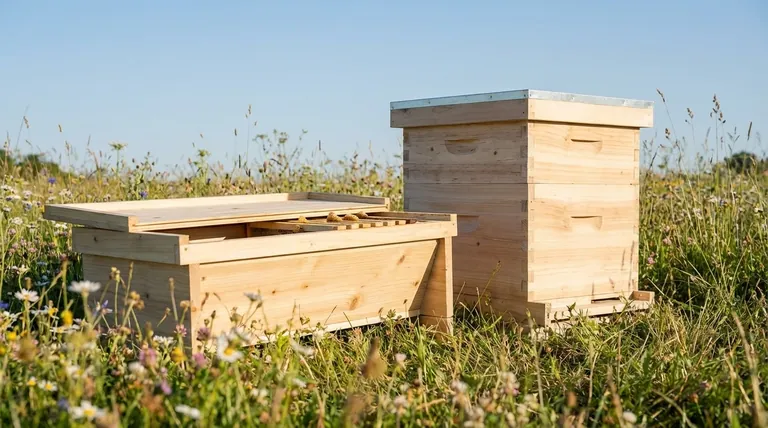The fundamental difference in flexibility between a Langstroth and a top bar hive stems directly from their core designs. The Langstroth's system of modular, vertically stacked boxes with removable frames provides unparalleled options for hive manipulation, expansion, and management. In contrast, the top bar hive's single, horizontal box design prioritizes simplicity and less intrusive beekeeping.
The Langstroth hive is designed for active intervention and scalability, offering beekeepers maximum control over the colony. The top bar hive is designed for simplicity and a more naturalistic approach, trading manipulative flexibility for ease of use.

The Foundation of Flexibility: Design Philosophy
The way each hive is constructed dictates the management options available to the beekeeper.
The Langstroth Hive: A Modular System
The Langstroth hive is a vertical system composed of separate, standardized boxes. Each box holds a set number of frames that can be easily removed and interchanged.
This modularity is the key to its flexibility. You can add boxes (called "supers") to expand space for brood or honey, and you can move individual frames within a hive or even between different hives.
The Top Bar Hive: A Horizontal System
A top bar hive is a single, horizontal box that sits on legs. Instead of full frames, it uses simple wooden bars that span the top of the hive.
Bees build their comb naturally, drawing it down from these top bars. Because the comb is not supported by a surrounding frame, it is more fragile and is not designed to be moved or rearranged extensively.
Key Advantages of Langstroth Flexibility
The modular design of the Langstroth hive unlocks several critical management techniques that are difficult or impossible with a top bar hive.
Seamless Vertical Expansion
As a colony grows, it needs more space. With a Langstroth hive, you simply add another box on top of the existing ones. This allows you to manage space for the brood nest and honey stores separately and effectively.
Interchangeable Frames
The ability to move frames is the Langstroth's most powerful feature. Beekeepers can move frames of brood to strengthen a weaker colony, split a strong colony into two, or easily conduct detailed inspections.
Efficient Honey Extraction
Langstroth frames, especially those with a plastic or wax foundation, provide structural support to the comb. This allows for honey to be extracted using a centrifuge, which spins the honey out while leaving the valuable drawn comb intact for the bees to reuse.
Superior Durability for Transport
The fully enclosed frames make the Langstroth hive robust and secure. This structural integrity is essential for commercial beekeepers who need to transport their hives for pollination services without the risk of comb breaking loose.
Understanding the Trade-offs
The flexibility of the Langstroth system comes with its own set of considerations.
Increased Management Complexity
Because the Langstroth hive offers so many management options, it also demands more knowledge from the beekeeper. You must know when to add or remove boxes and how to manage the colony's growth effectively.
Greater Physical Demands
A Langstroth super full of honey can weigh 50 pounds or more. Managing a Langstroth hive involves lifting these heavy boxes, whereas a top bar hive only requires you to lift one comb-laden bar at a time.
Foundation vs. Natural Comb
Most Langstroth beekeepers use frames with a pre-made foundation to guide comb building. Top bar hives, by design, encourage bees to build their own natural comb, a feature preferred by beekeepers who prioritize a more naturalistic approach.
Making the Right Choice for Your Goal
Your beekeeping objectives should guide your choice of hive.
- If your primary focus is maximizing honey production and active colony management: The Langstroth hive's expandability and interchangeable frames make it the superior choice.
- If your primary focus is a less physically demanding hobby with minimal heavy lifting: The top bar hive's single-bar inspection method is a significant advantage.
- If you intend to split hives, rear queens, or equalize colonies: The Langstroth's modular frame system is practically a necessity for these advanced techniques.
- If you need to move your hives for pollination or other purposes: The structural integrity of the Langstroth frame is non-negotiable for safe transport.
Ultimately, choosing the right hive means aligning the equipment's capabilities with your personal beekeeping philosophy and goals.
Summary Table:
| Feature | Langstroth Hive | Top Bar Hive |
|---|---|---|
| Hive Design | Vertical, modular boxes | Single, horizontal box |
| Expansion | Add boxes vertically for brood/honey | Limited to the single box size |
| Frame/Comb Handling | Interchangeable, durable frames | Fragile, non-interchangeable comb |
| Honey Harvesting | Centrifuge extraction (comb reusable) | Crush and strain method |
| Ideal For | Maximizing honey yield, active management, pollination services | Simplicity, natural comb, low physical demand |
Ready to Scale Your Beekeeping Operation?
For commercial apiaries and beekeeping equipment distributors, the Langstroth hive is the industry standard for efficiency and productivity. HONESTBEE supplies the durable, high-quality Langstroth equipment you need to manage your colonies effectively and maximize your honey harvest.
Contact HONESTBEE today to discuss your wholesale needs and discover how our beekeeping supplies can help your business thrive.
Visual Guide

Related Products
- Langstroth Bee Hives Bee Keeping Box for Beginners Beekeeping
- Long Langstroth Style Horizontal Top Bar Hive for Wholesale
- Professional 3-Bar Frame Grip with Integrated Hive Tool
- Multi-Functional Sliding Hive Entrance for Beekeeping
- HONESTBEE Professional Multi-Functional Hive Tool with Ergonomic Wood Handle
People Also Ask
- Why were wooden hives traditionally preferred? For Natural Beekeeping Aligned with Bee Biology
- Why are Langstroth hives recommended for beginners? Unmatched Support & Standardization
- What are the key features of the Langstroth beehive? A Guide to the Standard for Modern Beekeeping
- What basic equipment is needed to start beekeeping? Your Essential Guide to a Confident Start
- What are the different types of beehive boxes available? Choose the Right Hive for Your Apiary



















